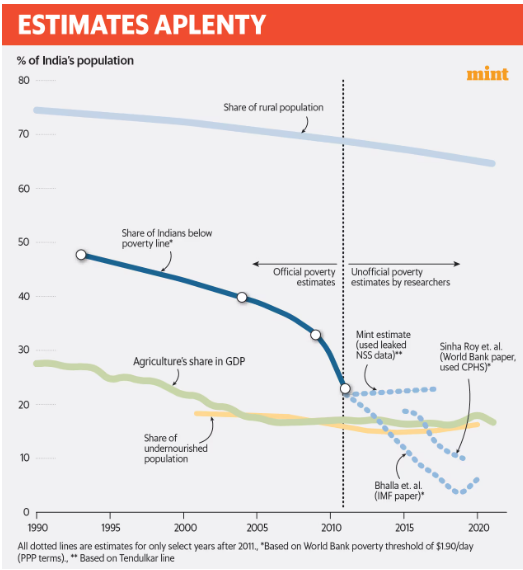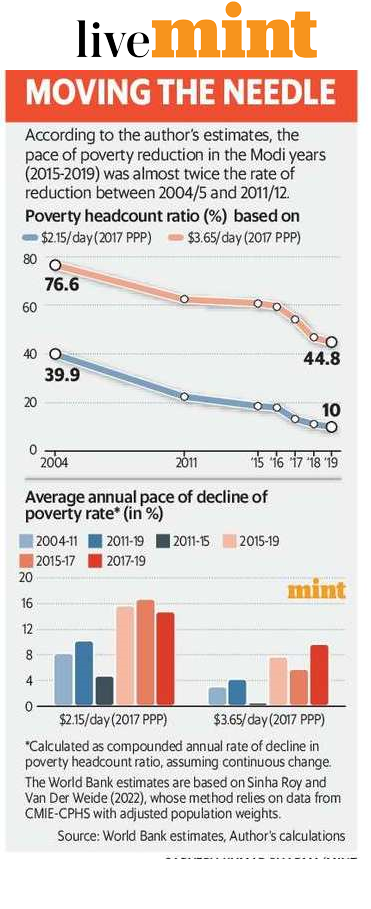ForumIAS announcing GS Foundation Program for UPSC CSE 2025-26 from 27th May. Click Here for more information.
Contents
Source: The post is based on the article “Poverty in India is yet again being overstated” published in the Livemint on 19th May 2023.
Syllabus: GS – 2: Issues relating to poverty and hunger.
Relevance: About India’s recent poverty measurements.
News: As the 2024 elections approach, the Great Indian Poverty Debate has again started. As the government has not released the 2017-18 Consumer Expenditure Survey (CES), many theories on poverty estimates are emerging.
What are the necessary factors in poverty measurement?
Head count: There has to be a consumption (or income) level below which individuals are deemed poor i.e. the “head count”. But population sizes differ, so the headcount becomes the percentage who are poor.
Accounting inflation: Large countries like India and China have differential spatial (urban, rural, and state) rates of inflation. So, there is a need for state-specific poverty lines.
Raise the poverty line accordingly: There is a need to change the level of poverty line with development i.e. as a country becomes richer (less poor), the poverty line should be raised.
About India’s poverty measurement criteria
According to newspaper reports, the government is undertaking two back-to-back consumer surveys. But the questionnaire remains pretty much the same as in 2011-12.
The only major change is, to get more accurate reporting, each household will be visited thrice instead of once. First, for questions pertaining to seven-day consumption (fruits and vegetables). Second, for measuring 30-day consumption (most items). Third, for more durable items (recall period of 365 days).
World Bank and other experts, including Nobel laureate Angus Deaton, recommended having food questions on a weekly basis recall (rather than monthly) since the late 1990s. Post 2011-12, the government accepted a Modified Mixed Recall Period (MMRP) method has become the official, and only, method of data collection by NSS.
| Read more: We shouldn’t let Indian poverty turn into a great eternal mystery |
What are the various theories on India’s poverty estimation?

Why experts are suggesting India’s poverty has reduced significantly in recent times?

Firstly, over the last decade (2011-12 to 2021-22), per capita GDP in India has increased by a cumulative 52%. Further, the real per capita consumption (national accounts data) grew at a healthy 3.13% CAGR, for an aggregate increase of 37%.
Secondly, average consumption increases by 37%. For example, the World Bank estimates a 67% “reasonable” pass-through of private final consumption expenditure (PFCE) growth to household consumption growth.
Thirdly, few experts said that India’s poverty remains constant around 20-25%. But the constancy of the poverty rate is not correct. Because a) According to the MMRP method, poverty in India in 2011-12 was 10 percentage points lower at 12.4%, b) The 2017-18 survey did not collect data for any method other than MMRP. So, the poverty lines should not be constant.
Fourthly, the World Bank has recently updated its poverty estimates for India and other countries. It said that the pace of poverty reduction is considerably higher during the post-2013 period.
According to World Bank estimates, the pace of poverty reduction in 2015-2019 was almost twice the rate of reduction between 2004-05 and 2011-12.
| Read more: There is no debate: There has been a persistent decline in poverty in India |
At present, three organizations (NSSO, NCAER and CMIE) have ongoing surveys on consumption and therefore estimates of poverty.




